If you are unfamiliar with tonkotsu ramen noodle soup, this Japanese soup is the one for you. It is made with pork bones and is rich in collagen. The broth is a milky, creamy, and flavorful mixture. Traditionally, tonkotsu ramen is served with thin, straight noodles. To make it more authentic, you can serve it with pork, vegetables, and/or boiled eggs.
Tonkotsu Ramen Noodle Soup Recipes
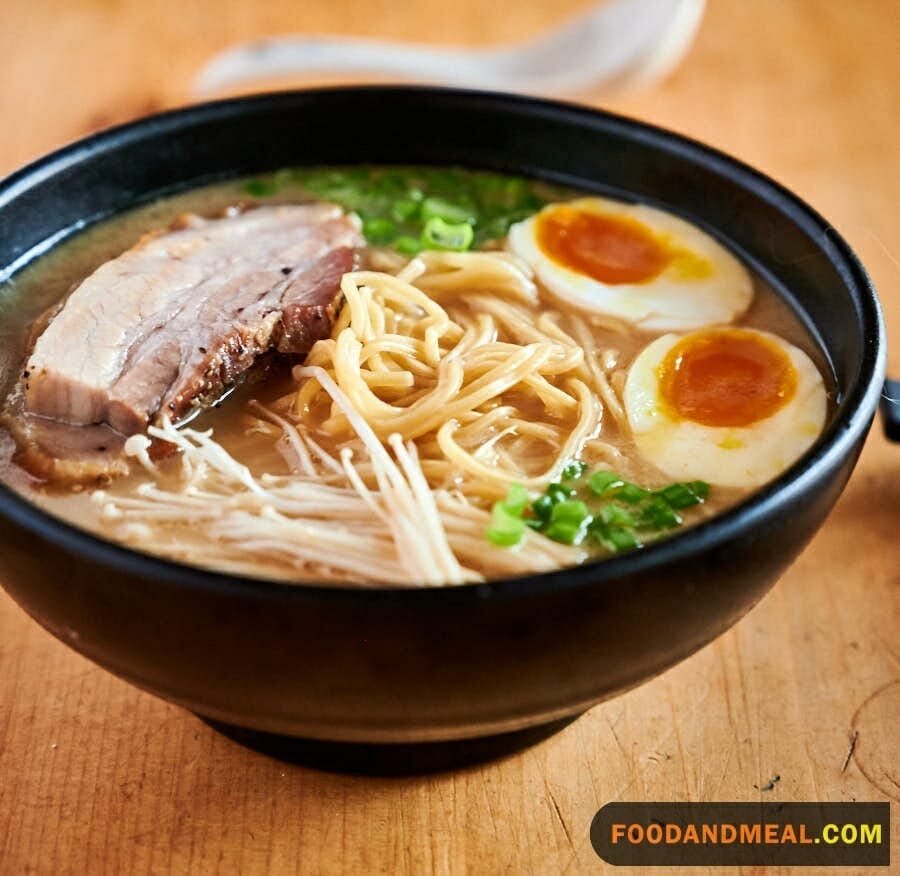
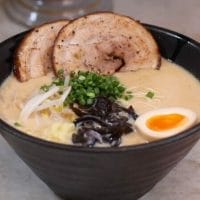
Tonkotsu Ramen Noodle Soup
Ingredients
For soup:
- 2 bunches of ramen noodles
- 1 tbsp. miso paste spicy
- 1 tbsp. miso red
- 20 - 27 fl. oz. soup stock pork bone
For pork mince:
- 2 tsp. oil sesame
- 2 tsp. oil vegetable
- 2 minced cloves of garlic
- 10 & 1/2 oz. pork mince
- 2 tbsp. soy sauce low sodium
- 2 minced cloves of garlic
- 2 red chilies fresh
For serving, as desired
- 1/2 sheet of nori seaweed
- Sliced green onions
- Boiled eggs marinated
- Ginger red pickled
Instructions
- Prepare soup stock in large sized sauce pan. Bring to low simmer.
- Once soup has reached a simmer, add miso paste and red miso. Stir till combined evenly. Remove from heat. Set aside.
- Prepare ramen noodles using package directions. Drain them. Set them aside.
- Brown mince in fry pan. Add remainder of ingredients for seasoned pork mince. Cook for three to four minutes.
- Reheat soup stock. Add noodles to large sized ramen bowl. Top with soup, then pork mince. Serve with toppings, as desired.
Video
Notes
Nutrition
© Food And Meal
This website provides approximate nutrition information for convenience and as a courtesy only. Nutrition data is gathered primarily from the Spoonacular Database, whenever available, or otherwise other online calculators.
Alternative Method: Tonkotsu Ramen in the Instant Pot
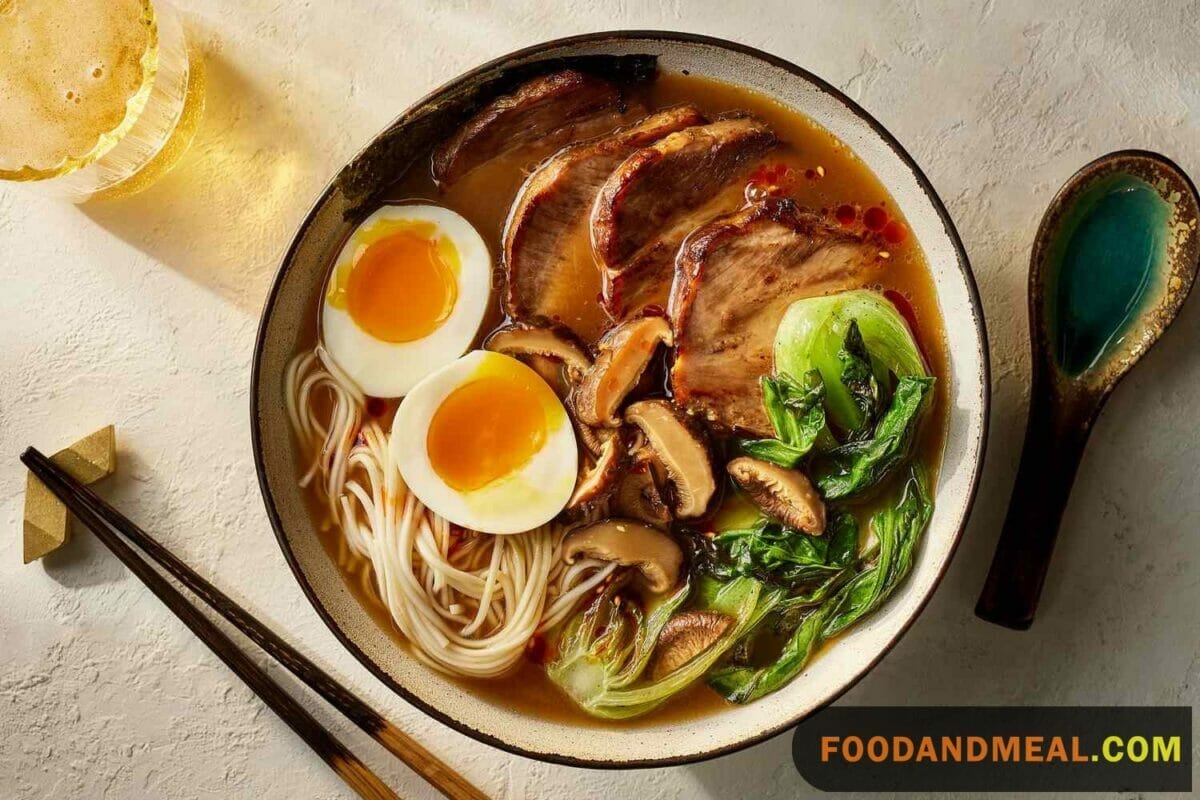
Ingredients:
- 2 pounds pork bones
- 1 onion, halved
- 4 cloves garlic, crushed
- 1 piece ginger (2 inches), sliced
- 8 cups water
- 2 tablespoons vegetable oil
- 2 teaspoons sesame oil
- 2 tablespoons miso paste
- 1 tablespoon soy sauce
- 1 tablespoon sake
- 1 teaspoon salt
- 1 pound fresh ramen noodles
- Toppings of your choice: soft-boiled eggs, sliced green onions, sliced mushrooms, nori sheets, and bamboo shoots
Instructions:
Broth Preparation:
-
- In your Instant Pot, set it to ‘Sauté’ mode and heat the vegetable oil. Add the pork bones and sear them until lightly browned.
- Add the onion, garlic, and ginger, and continue to sauté for a few more minutes.
- Pour in the water, miso paste, soy sauce, sake, and salt. Stir to combine.
- Secure the lid of the Instant Pot and set it to ‘Manual’ or ‘Pressure Cook’ mode. Cook on high pressure for 2 hours.
- Once done, allow the pressure to release naturally for about 20 minutes, then manually release any remaining pressure.
Noodle and Topping Prep:
-
- While the broth is cooking, prepare your ramen noodles according to the package instructions. Set them aside.
Assembly:
-
- Strain the Tonkotsu broth, discarding the solids, and return the liquid to the Instant Pot.
Serving:
-
- To serve, place a portion of cooked noodles in each bowl.
- Ladle the hot Tonkotsu broth over the noodles.
- Customize your bowl with your favorite toppings: soft-boiled eggs, sliced green onions, mushrooms, nori sheets, bamboo shoots, and anything else you desire.
Enjoy:
-
- Dive into your Instant Pot-made Tonkotsu Ramen. The rich and creamy flavors, along with the tender pork and delectable toppings, are sure to impress your taste buds.
Tips for making Tonkotsu Ramen Noodle Soup
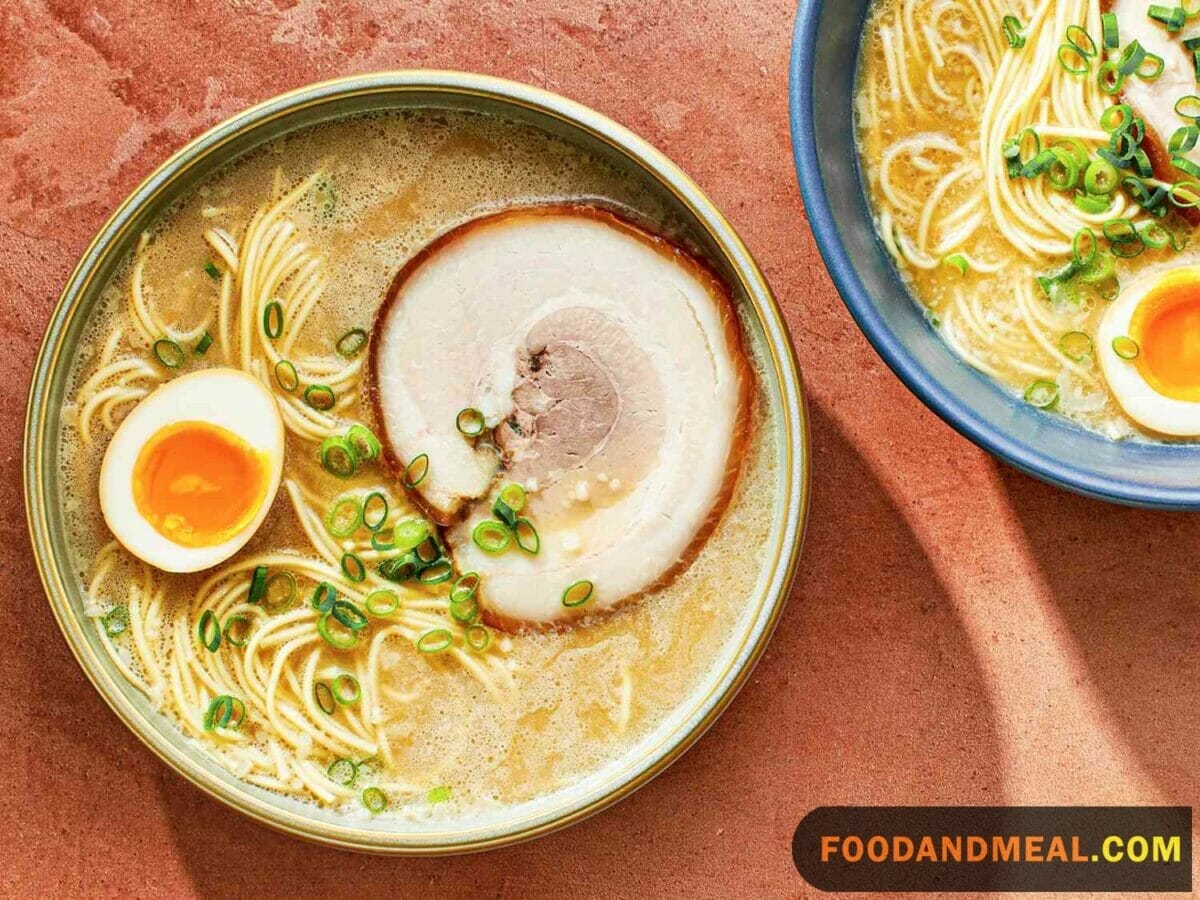
Cooking Tips
- Patience is Key: Whether you’re using the traditional stovetop method or the Instant Pot, don’t rush the broth. Low and slow simmering is what extracts the rich flavors from the pork bones. Give it the time it deserves.
- Skim the Scum: When simmering the broth, regularly skim off any impurities that rise to the surface. This ensures a cleaner, clearer, and more flavorful broth.
- Customize Toppings: Tonkotsu Ramen is all about personalization. Experiment with different toppings like marinated bamboo shoots, corn, or spinach to suit your preferences.
- Fresh Noodles Matter: If you can, use fresh ramen noodles. They cook quickly and have a fantastic texture. If using dried noodles, cook them according to package instructions just before serving.
- Reheat Gently: If you have leftovers, reheat the broth gently over low heat. Overcooking can cause the broth to become greasy.
Serving Suggestions
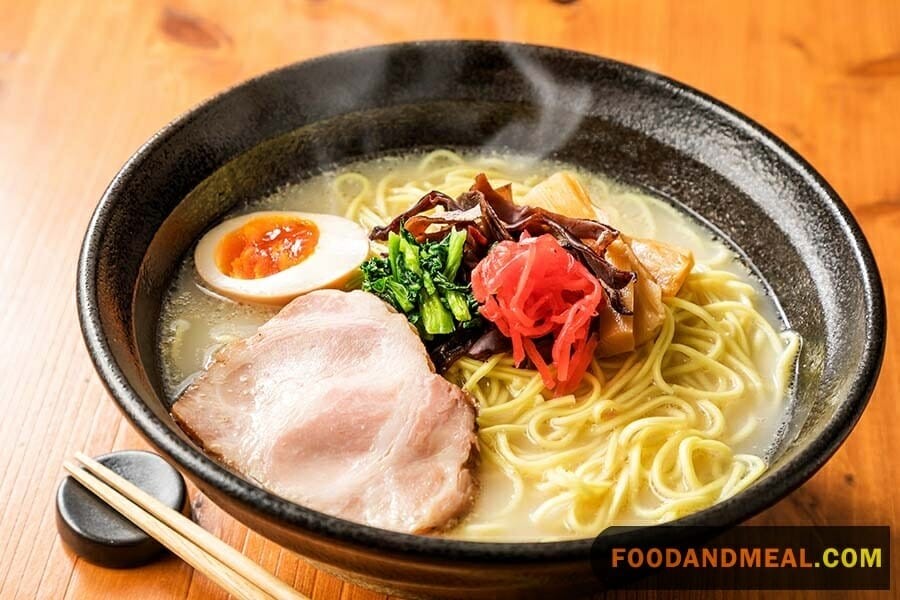
- Classic Pairing: Serve your Tonkotsu Ramen with a side of gyoza (pan-fried dumplings) for a complete Japanese meal experience.
- Pickled Delights: Japanese pickles, like takuan (pickled daikon radish), or kimchi, provide a delightful contrast to the rich and creamy broth.
- Cold Beer or Sake: A chilled beer or a cup of hot sake complements the flavors of Tonkotsu Ramen beautifully. The effervescence of beer or the warmth of sake balances the richness of the broth.
- Ramen Eggs: Soft-boiled marinated eggs (Ajitsuke Tamago) make for a mouthwatering garnish. The creamy yolk adds a luxurious touch to each bite.
- Extra Nori Sheets: If you love the oceanic umami flavor of nori, serve extra sheets on the side for those who want to enhance their ramen.
FAQs about Tonkotsu Ramen Noodle Soup
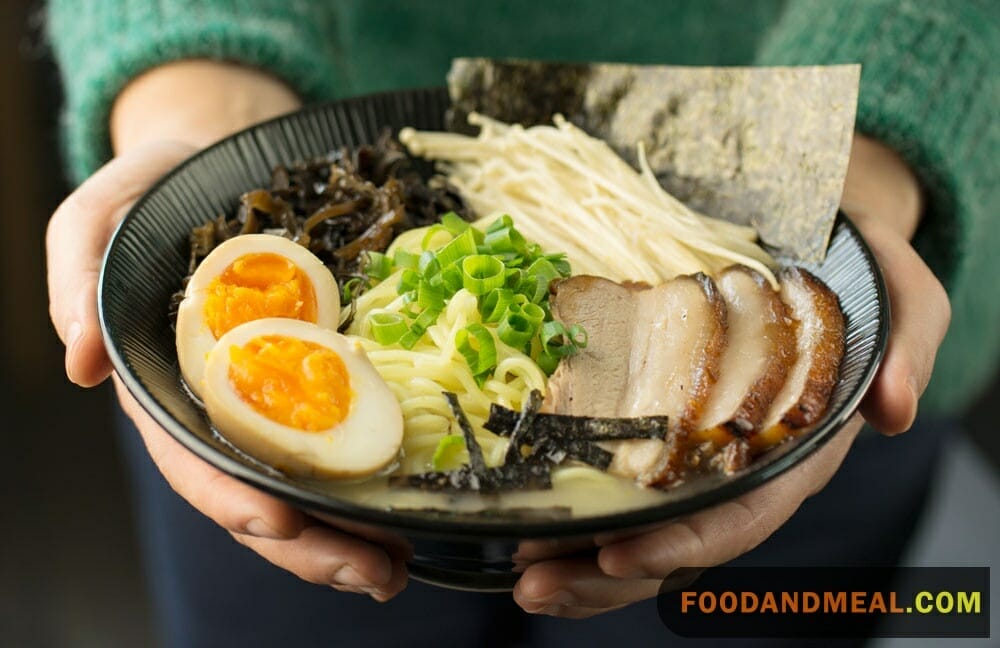
- How do I store leftover Tonkotsu Ramen? To store leftovers, separate the broth from the noodles and toppings. Keep the broth in an airtight container in the refrigerator for up to three days. Noodles can be stored separately, but they are best enjoyed fresh. Reheat gently on the stove when you’re ready to indulge again.
- Can I make Tonkotsu Ramen vegetarian or vegan? Yes, you can! Use vegetable broth and substitute the pork toppings with tofu or seitan. Adjust the seasonings to mimic the umami-rich flavors of the traditional version.
- Why does my Tonkotsu Ramen broth turn greasy? The broth can become greasy if it’s boiled too vigorously or if you haven’t properly skimmed off impurities. Simmer gently, and regularly remove any scum that forms on the surface.
- What’s the difference between Tonkotsu Ramen and other ramen varieties? Tonkotsu Ramen is known for its rich and creamy pork bone broth. Shoyu Ramen uses a soy sauce-based broth, Shio Ramen features a clear, salt-based broth, and Miso Ramen incorporates a fermented soybean paste for a distinct flavor.
- Can I freeze Tonkotsu Ramen for later? Freezing is possible but not recommended for the best taste and texture. The broth can separate upon thawing, and the noodles may become mushy. If freezing, store broth and noodles separately in airtight containers. Thaw in the fridge and reheat gently.
Craft Tonkotsu Ramen at home – creamy, savory, and authentic. Share this delectable recipe and subscribe for more culinary adventures.
I'm James F Anderson, a noted sous chef from London and a Le Cordon Bleu alumnus. My career began in a Michelin-starred Parisian eatery, where my blend of classic and contemporary cooking, using seasonal ingredients, earned accolades. Recognized in culinary publications and on cooking shows, I’m committed to mentoring aspiring chefs and delivering memorable dining experiences, marking me as a standout talent in the culinary world.
